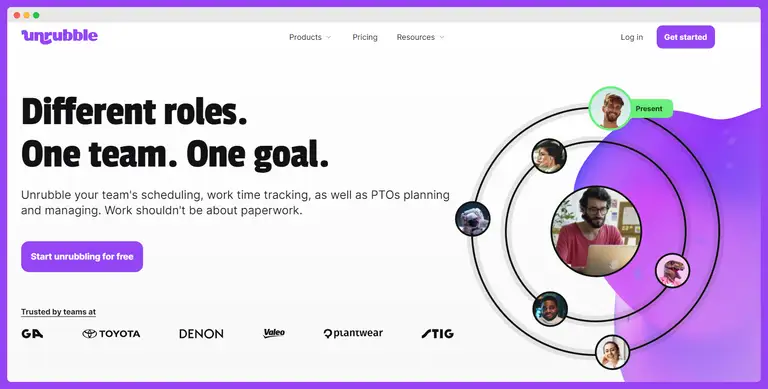Creating a thriving and high-performing workplace begins with the foundations you lay.
Imagine having a workforce that shows up on time, consistently delivers their best, and contributes to a positive workplace culture.
The key to this utopian scenario lies in something often overlooked – your employee attendance policy.
What is it? How and when to create it and why?
Get ready for answers to all these questions + a special, free template.
What is an attendance policy?
An attendance policy is a set of rules and guidelines established by an organization to regulate and manage employees' attendance and punctuality at work.
It outlines expectations regarding when employees are required to show up for work, what constitutes acceptable attendance, and the procedures for requesting and tracking time off.
Additionally, such a policy may detail disciplinary actions or consequences for employees who:
- consistently arrive late,
- have excessive unexcused absences, or
- fail to adhere to the attendance rules.
The primary purpose of an attendance policy is to ensure a productive and consistent work environment while providing clarity to employees about attendance-related expectations and consequences.
Why is an attendance policy important for your HR team and overall business?

An attendance policy is a document that holds a paramount role within your organization. It serves as a foundation for maintaining an efficient and disciplined work environment.
Let's see why having an attendance policy is vital for your HR team and overall business:
Emphasizing the importance of timeliness
One of the primary purposes is to continually notify all employees about the critical importance of showing up to work on time. This emphasis on punctuality reinforces the idea that arriving tardy or engaging in unexpected absences is not acceptable. As such, it fosters a culture of responsibility and accountability among your workforce.
Establishing uniform guidelines
An attendance policy plays a crucial role in standardizing the expectations for all employees.
It clearly outlines guidelines regarding specific times, scheduled shifts, and what constitutes being absent or late. When you provide this clarity, you make sure that every team member comprehends the rules and responsibilities associated with their role.
Clarifying attendance tracking methods
Within the framework of a company attendance policy, the methods for attendance tracking are explicitly explained. It doesn't matter whether it's digital systems, time clocks, or other mechanisms. Employees are informed about how their punctuality or attendance is monitored. This transparency helps prevent any misunderstandings or disputes concerning attendance records.
Demonstrating disciplinary procedures
Inevitably, there will be instances of early departure, unscheduled absences, or poor attendance. A good attendance policy outlines the specific disciplinary methods that will be applied in such cases.
It defines how instances of being absent or late will be addressed, which may include verbal warnings, written warnings, or other corrective actions. These procedures establish a consistent and fair approach to handling attendance-related issues.
When to create an attendance policy
- When late arrivals become a recurring issue.
- When excused absences need to be properly defined.
- When a point system for tracking attendance is needed.
- When employees are expected to be present at work on time.
- When employees are absent frequently or without proper notice.
- When progressive discipline for attendance-related issues is necessary.
- When employees must report to work regularly according to a set work schedule.
- When an attendance system is required to monitor and record employee attendance.
- When employees work from home or have flexible work arrangements, which requires clear guidelines.
How to create an attendance policy?

Creating an effective attendance policy is essential for promoting positive attendance and reducing absenteeism in the workplace.
Here's a step-by-step guide, covering various aspects related to attendance:
Set clear attendance expectations
Begin by defining what constitutes proper attendance for your organization. Clearly communicate start times, scheduled shifts, and expectations regarding regular attendance to all employees.
Address tardiness
Include provisions for handling tardiness. Specify the acceptable grace period for being late to work. Outline how consecutive days of this practice will be managed.
Define types of leave
Highlight the difference between various types of leave, such as sick leave, vacation days, personal days, and excused or unexcused absences. Explain the procedures for requesting time off.
Explain the leave approval process
Describe how employees should request leave, whether it's through a formal system, direct supervisor, or HR. Point out the importance of advance notice, especially for scheduled absences.
Address FMLA and other legal considerations
If applicable, address legal requirements such as the Family and Medical Leave Act and other relevant laws. Be sure that your policy aligns with these regulations. Otherwise, you could be in trouble.
Track the attendance
Explain how attendance will be tracked, whether through a digital system, time clock, or other methods. Emphasize the importance of maintaining an accurate attendance record. You can also introduce special employee attendance lists that your employees must complete regularly.
Introduce disciplinary action
Outline a progressive disciplinary action plan for dealing with attendance issues. Include verbal warnings, written warnings, and potential consequences for excessive absenteeism.
Define job abandonment
Define what constitutes abandonment of a job and the process for addressing it when employees leave work without proper notice.
Provide support for proper attendance
Encourage employees to maintain a high attendance. Recognize and reward those who consistently adhere to the policy.
Have regular policy reviews
Stress the importance of regularly reviewing and updating the attendance policy to ensure it remains effective and compliant with labor laws.
Add everything to an employee handbook
Include the attendance policy in the employee handbook as a reference for all staff members.
When you create a comprehensive attendance policy, you not only promote great attendance but also provide a clear framework for addressing absenteeism and tardiness. This will lead to improved productivity, better employee morale, and effective human resources management.
The best & most effective employee attendance policy template
At Unrubble, we know that crafting the perfect attendance policy is not the easiest task.
That's why we come to your rescue with our top-tier template:
[Your Company Name]
Employee Attendance Policy
Introduction
At [Your Company Name], we understand that a consistent and punctual workforce is crucial for our success. This Employee Attendance Policy has been created to set clear expectations, provide guidelines, and maintain a productive and positive work environment.
Purpose
The purpose of this policy is to:
- Emphasize the importance of punctuality and regular attendance.
- Standardize attendance expectations for all employees.
- Define the procedures for requesting and approving time off.
- Establish methods for tracking attendance.
- Outline disciplinary actions for attendance-related issues.
Scope
This policy applies to all employees, including full-time, part-time, and temporary workers, at [Your Company Name].
Policy Details
Attendance Expectations
- All employees are expected to report to work on time as per their work schedule.
- Tardiness, unscheduled absence, or early departure is not acceptable.
Tardiness
- Tardiness is defined as arriving after your scheduled start time.
- A grace period of [Specify Grace Period] minutes is allowed for occasional tardiness.
- Consecutive days of tardiness will be addressed as a separate issue.
Types of Leave
- Employees are eligible for various types of leave, including sick leave, vacation days, personal days, excused absences, and unexcused absences.
- Sick leave, vacation days, and personal days must be requested in advance.
Leave Approval Process
- All employees must submit leave requests [Specify Time Frame] days in advance.
- Leave requests can be made through the [Specify Leave Request System].
- Immediate supervisors or HR must approve all leave requests.
FMLA and Legal Considerations
- [Your Company Name] complies with the Family and Medical Leave Act and other relevant labor laws.
- Ensure that your leave requests align with these regulations.
Attendance Tracking
- Attendance will be tracked using [Specify Attendance Tracking Method].
- Employees are responsible for recording their attendance accurately.
Disciplinary Action
- [Your Company Name] follows a progressive disciplinary action plan for attendance issues.
- The disciplinary process includes verbal warnings, written warnings, and potential consequences for excessive absenteeism.
Job Abandonment
- Job abandonment is defined as leaving work without proper notice.
- The process for addressing it includes [Specify Process].
Support for Good Attendance
- [Your Company Name] encourages and recognizes employees with high attendance records.
- Rewards and recognition may include [Specify Rewards].
Regular Policy Reviews
- This policy will be reviewed regularly to ensure its effectiveness and compliance with labor laws.
- Any updates or changes will be communicated to all employees.
Employee Handbook Inclusion
- This attendance policy is included in the [Your Company Name] Employee Handbook.
- All employees are encouraged to refer to the handbook for guidance.
Conclusion
By adhering to this Employee Attendance Policy, we aim to create a workplace that values punctuality, accountability, and productivity. Your commitment to following these guidelines will contribute to the overall success and positive work environment at [Your Company Name].
[Your Company Name] reserves the right to modify, interpret, or cancel this policy at any time.
Effective Date: [Specify Effective Date]
P.S. And if you're looking for an effective time tracker, work scheduler and PTO management solution - try Unrubble.

Unrubble is your go-to solution for simplifying employee attendance and PTO management. With our user-friendly platform, you can say goodbye to the hassles of paperwork and focus on what truly matters in your job. Unrubble offers precise time tracking, efficient scheduling, and a seamless request management system for absences, work-from-home arrangements, and vacations. Join over 149,950 satisfied users who trust Unrubble to streamline their workforce management. Make scheduling and attendance management a piece of cake with Unrubble!
Wrapping up
An attendance policy is a critical tool for maintaining a productive and disciplined workplace.
Consider implementing our guidelines to create an effective attendance policy that supports your HR team and contributes to your overall business success. And be sure to take advantage of our free template.
With the right policy in place, you'll set the stage for better attendance, higher productivity, and a more positive work environment. And if you want to get moving in the right direction, tracking your time is a great first step. Grab your free trial of Unrubble today to get started!








